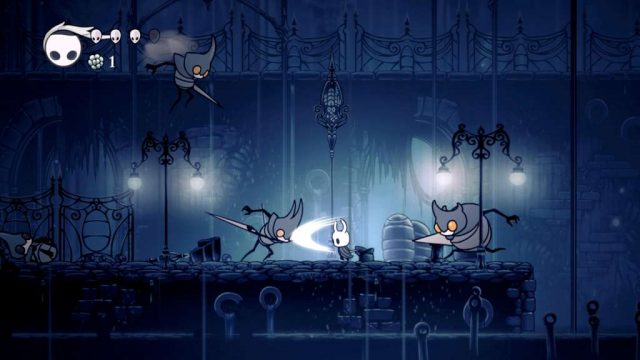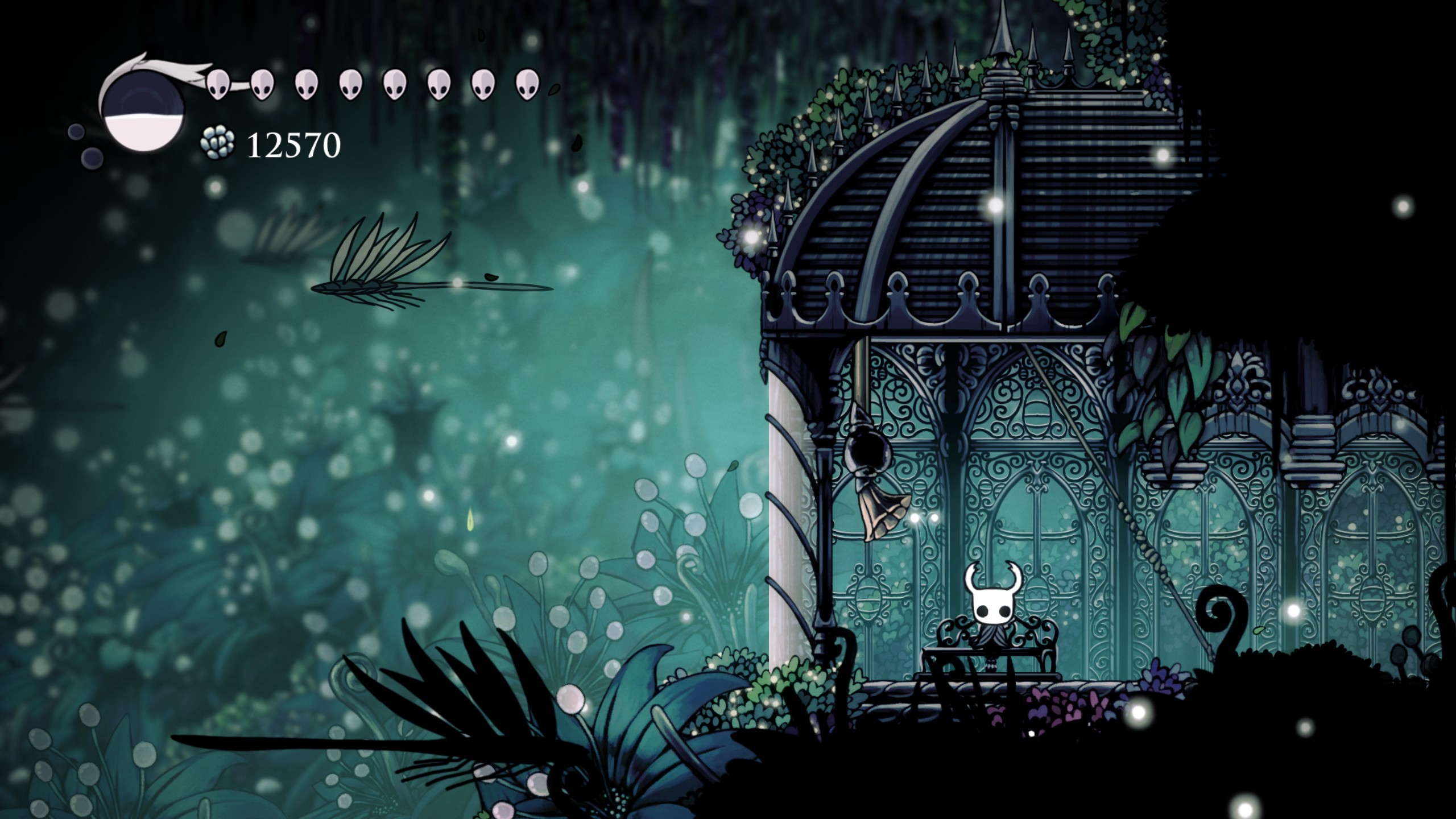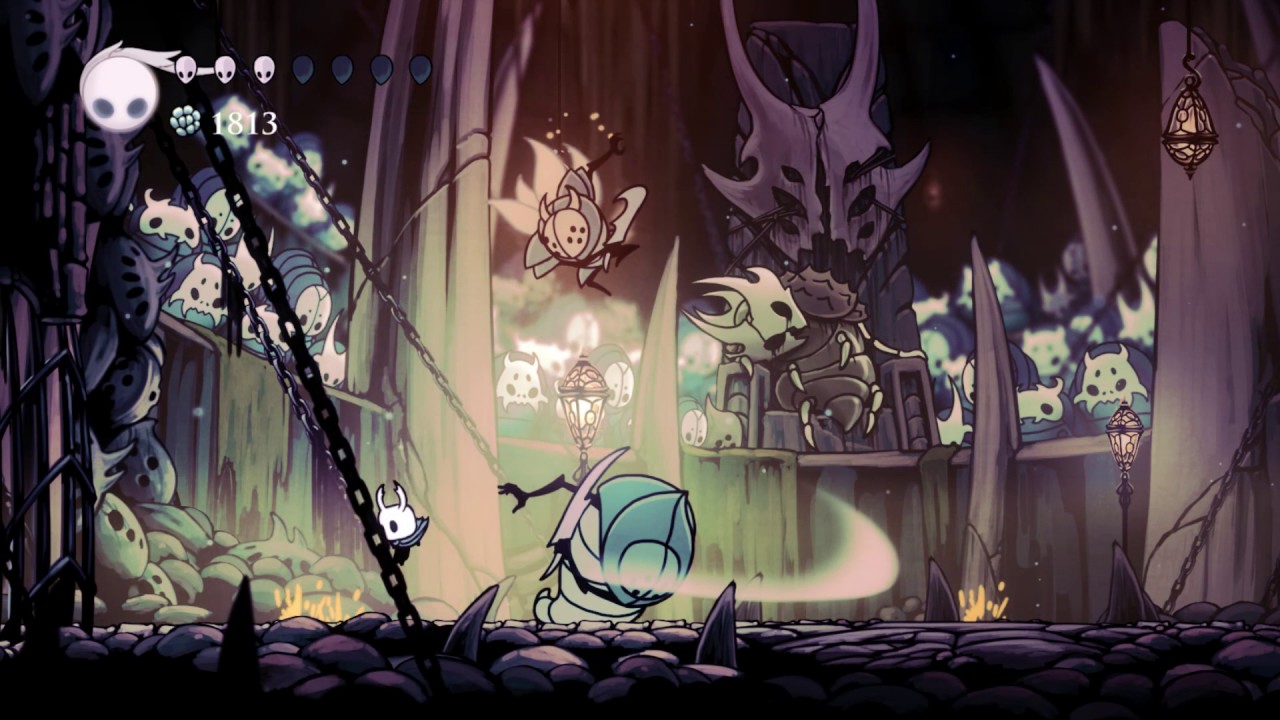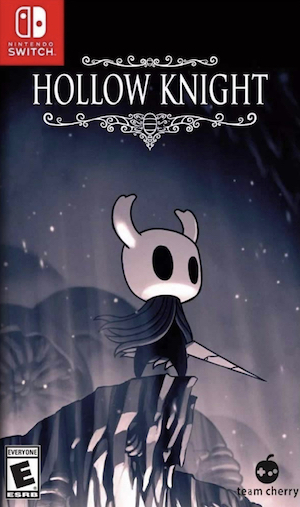
It didn’t take me long after beginning my playthrough of Hollow Knight to realize that I’d stumbled onto something truly special. Though the game begins with little to no context for what’s going on or why you’re doing what you’re doing, and only starts you off with a very basic move-set that encompasses both, combat and platforming, from the get-go it exudes a sense of polish and confidence that is very rarely seen in most other video games, even ones that are made on a budget that is literally a hundred times that of Hollow Knight’s. The sombre music, the beautiful hand-drawn art, the tense combat, and the precise platforming all pulled me into the experience almost immediately.
But though these things had already given me an impression of the level of quality the game would exhibit going forward, as I played more and more, I realized how little I’d known. Because Hollow Knight is a game that constantly grows, a game that is always getting better, a game that incessantly and relentlessly ramps up the quality and intensity of every single one of its mechanics, every single one of its aspects, throughout the entirety of its surprisingly long play time. And it does it all so gradually, so seamlessly, that it never feels abrupt or overwhelming. It all feels like a natural progression, like a large, cohesive whole, as it progressively continues to add layer upon layer upon layer, to ultimately deliver one of the most satisfying, rewarding, and stunning Metroidvania experiences of all time.
"Hollow Knight is a game that constantly grows, a game that is always getting better, a game that incessantly and relentlessly ramps up the quality and intensity of every single one of its mechanics, every single one of its aspects throughout the entirety of its surprisingly long play time."
And natural progression really is the best way to describe it- because that’s exactly what progression is like in Hollow Knight. It’s no secret that this is a very, very challenging game. This is not a game for the kind of player that lacks patience, or doesn’t appreciate a good test of skill. Hollow Knight is defined by a constant sense of tension. It always keeps you on your toes, not just during boss fights, but during fights against regular enemies as well, and even during many of its more demanding platforming-centric sections. But as the game moves forward, you’re constantly getting better; not through new upgrades or better equipment (though that certainly plays a part as well), but because you just learn.
Learning enemies’ attack patterns, learning and perfecting your own moves, when to dodge, when to jump, when to dash, is all deeply imbued in Hollow Knight’s core. A dozen hours in you might return to one of the game’s earlier areas, and discover that enemies that almost seemed like bosses and mini-bosses when you first met them now all easily fall to your blade. Enemies that may have put your skills to the test hours ago might seem like mere roadblocks a few hours down the line, simply because, having faced much worse trials and tribulations since then, you now just feel like you’re better equipped to handle the game’s earlier challenges. Through trial and error (and then even more error), Hollow Knight forces you to teach yourself, rather than providing you with tutorials in any form, as it constantly prods and encourages you to gain mastery over all of its mechanics.
The reason that works as perfectly as it does is because Hollow Knight manages to strike that perfect, elusive balance between hard and fair. While playing this game, you will die a lot. Dying is part of the process, it’s how you learn, and how you get better. And though there will be many occasions when the game’s difficulty will make you want to rip your hair out and scream in frustration at everything in general and nothing in particular, it will never be because the game was unfair or cheap. Every time I died in Hollow Knight, it was because of something I didn’t do right- a mistimed jump, an ill-advised dodge, an impatient attack, a panic-induced dash.
Every time you die, you will also lose a portion of your Soul bar (which is basically your mana), and all of the money (called Geo) you have managed to collect so far. You can, though, go back to the area you died last, defeat a spirit of your past self, and regain everything that you lost. Anyone who’s played any of From Software’s Soulsborne games will obviously be familiar with this mechanic, and it fits very well in Hollow Knight as well, adding an extra layer of inviting challenge, even to the process of dying. The one aspect of Hollow Knight that I can level criticism at, as far as its difficulty goes, is its bench placement. Benches are safe areas that act as checkpoints, where you can save your game and update your map (a crucial activity), but there are a few times when benches are placed quite far away from bosses. This doesn’t happen a lot, but when it does happen, the repeated slogs back after dying, from a bench to a boss can become a little wearisome, especially when you’re up against a particularly challenging boss that will kill you a lot.
"Through trial and error (and then even more error), Hollow Knight forces you to teach yourself, rather than providing you with tutorials in any form, as it constantly prods and encourages you to gain mastery over all of its mechanics."
That never becomes too much of a problem though, because the sheer and simple act of just playing Hollow Knight, moment to moment, is also an absolute joy, so no matter how many times you die, no matter how frustrated you get, you will almost always want to immediately jump back into things. The game has incredibly tight, precise, and responsive controls. From your attacks and dodges to your jumps, everything you do feels crisp, and the inch-perfect nature of the animations instills you with confidence about every one of your moves. With each move you pull off, you always know what to expect, always know how the game will react, and this precise nature contributes even further toward making the game’s difficulty seem throughly challenging, but constantly fair. Not once was I even slightly worried about the game messing up and behaving in unpredictable ways, or reading my inputs wrongly.
The precise nature of both, platforming and combat, is made even more impressive when you consider that Hollow Knight manages to retain these qualities even as both these aspects continue to grow increasingly more complex throughout the game. In true Metroidvania fashion, the combat and platforming in Hollow Knight are always expanding, becoming more intricate and vast with every new ability you learn, and with each new area you progress to. As you work your way through the game, you will begin to see an increasing number of enemies with more unreadable and varied attack patterns, and find more collectibles and abilities locked behind deathtraps that will require you to nimbly pull off strings of varied platforming moves with faultless timing. The fact that in spite of continuously adding an increasing number of layers onto its core, the game still manages to feel so perfectly responsive all the time, is indeed worthy of all the plaudits it can get.
Then there’s the matter of Charms, which, in their own way, add a completely new level of strategy and nuance to the game. Hollow Knight allows you to equip Charms, which give you certain abilities, or improve some of the abilities you already have, but it makes things interesting by only giving you a limited number of notches to hold your Charms. The more powerful a Charm is, the more notches it will require, and while you can always “Overcharm” yourself by equipping more Charms than you have notches for, the game only allows you to do so by making it so that while you’re Overcharmed, you receive twice the regular amount of damage for each hit you take. Some Charms are also more compatible with others, and finding the right combos can net you valuable enhancements.
Given just how many Charms there are, and how many possible combinations you can find, it’s fair to say that you’ll be swapping them in and out quite a lot. For example, in my specific case, I had a build of Charms that I would equip before tough boss fights, while I had yet another that I would equip when I needed to gather money, and then yet another that I would use during regular exploration. There are offensive bonuses, defensive bonuses, passive bonuses, charms that let you dash more often, charms that strengthen some of your ranged attacks, charms that make your weapon longer, charms that can break if you die- all said, they add a surprising level of depth and nuance to the entire game.
"The sheer and simple act of just playing Hollow Knight, moment to moment, is an absolute joy, so no matter how many times you die, no matter how frustrated you get, you will almost always want to immediately jump back into things."
Another mechanic that helps elevate Hollow Knight’s combat is Soul. This depleting resource is what you use up while using your elemental abilities, which you gain throughout the course of the game, but Hollow Knight adds a unique twist to the proceedings, by tying Soul with replenishing your health as well. Healing up and gaining back those lost bits of your health uses up Soul, and doing so also renders you unable to move or do anything while the process is underway. Deciding when to stop and heal yourself, especially in the middle of hectic encounters or tense boss fights, can be a very tricky decision, and by that same token, deciding to take the risk of not healing up and instead choosing to use your Soul to unleash a powerful attack presents an interesting risk vs. reward element. The fact that you refill your Soul meter by striking at enemies only serves to enhance that particular aspect of the game- if you’re low on health and out of Soul, to heal yourself you’re first going to have to get more Soul, and thus go out of your way to kill enemies, any one of whom could potentially kill you.
Like all the best games out there, though, Hollow Knight doesn’t focus all its energies on just one or two areas. Just as it constantly keeps expanding its combat and its platforming, so too does it keep adding layer upon layer to its giant map. Metroidvania games have long been stalwarts of slowly introducing players to massive, interconnected maps bit by bit, but Hollow Knight perhaps does it better than almost any other game in the genre. The world of Hallownest is surprisingly huge, and even dozens of hours into the game you’ll be chancing upon entirely new areas, or undiscovered portions of old sections of map. As you earn more abilities that allow you to get to previously inaccessible areas, you’ll find yourself seeking out areas that you could previously only see, but never reach. As such, each section of the map constantly loops back on itself, and so too does all of the map in its entirety. Level design is, without a doubt, perhaps one of Hollow Knight’s biggest strengths. It wouldn’t, in fact, be hyperbolic to say that it is downright ingenious. It’s classic Metroidvania, but does it better than perhaps any other game has ever done it in the past.
Another one of the game’s biggest strengths is its bosses. The boss battles in Hollow Knight are some of the best I’ve seen in a long, long time in any game, 2D or 3D. With incredible design, varied and hard to predict attack patterns, and permeated with that same sense of hard-yet-fair difficulty that characterizes the entire game, boss fights in Hollow Knight are perhaps the game’s highlights. With each new area you enter, you’ll be giddily anticipating the next set-piece battle, and not once will you be disappointed with what the game throws at you. Boss encounters are gruelling, demanding ordeals that will put your skills to the test like nothing else in the game, and the swelling sense of victory and satisfaction you get after you beat a particularly difficult boss is simply unparalleled. It defies description. This is how you do “pride and accomplishment”.
That strong design is not just restricted to bosses, though. Even the regular enemies you come across in Hollow Knight are exciting and formidable foes. Though things start off nice and slow, as the game ramps up, it continues to throw a constantly growing variety of enemies your way, with varied attacks, different kinds of movements, and different ways of being defeated. It is thanks to this immense variety and the consistently strong design of almost each enemy in the game that prevents the game from ever getting boring. Even while you’re just exploring, navigating areas while fighting different kinds of enemies and figuring out how to beat each one and how to dodge each’s attacks makes every moment of the game truly engrossing.
"Boss encounters are gruelling, demanding ordeals that will put your skills to the test like nothing else in the game, and the swelling sense of victory and satisfaction you get after you beat a particularly difficult boss is simply unparalleled. It defies description. This is how you do “pride and accomplishment”."
But Hollow Knight doesn’t just stand tall with the kings of its genre in terms of gameplay and level design. It also does so in terms of its story, and how it chooses to tell it. It doesn’t have a traditional story, nor does it tell that story in the way you would see in most other games. Like in so many things that it does, Hollow Knight’s storytelling takes cues from From Software’s Soulsborne games, with its passive, lore-driven approach to presenting its narrative. To tell you anything about the story and the secrets it reveals would truly be spoiling it, because it really is an integral part of the experience to, piece by piece, uncover new bits of history of the tragedy that struck Hallownest, new bits of information on what’s going on and what your ultimate goal is. Hollow Knight tells the majority of its story not through heavy-handed exposition dumps or dedicated cutscenes, but through intermittent pieces of dialogue, descriptive text, and environmental storytelling. And it works wonderfully well. By the time I was done with the game, I was absolutely enraptured by this tragic, captivating tale with its incredible lore.
That tragic tale, however, never gets too overbearing, because of how well Hollow Knight’s overall sense of atmosphere not only complements it, but also often balances it out. Its beautiful, hand-drawn art style is stunning to behold, with each area of the game showcasing its own unique visual flair and its own characteristics, with each character, enemy and boss being incredibly well animated. All of that, along with the game’s sombre, melancholy soundtrack, compounds the overall sense of atmosphere manifold. Hollow Knight conveys a sense of isolation and despair without ever saying too much, thanks to its incredible visual style and its beautiful art. But it never becomes too overbearing, because the game is also careful to inject little doses of humour into the experience every now and then. The characters you meet all have quirky personalities, while some of them (including one vendor in particular) have endearing, charming designs and animations. The humour the game presents is never on-the-nose, and it never feels incongruous with the rest of the experience. Instead, it works in conjunction with the game’s otherwise sombre nature to strike the perfect balance and deliver a truly harmonious experience. That, I believe, is the result of truly excellent writing across the board.
But the thing that surprised me most about Hollow Knight, above all else – and continues to surprise me still – is just how packed full of content the game is. Indie games have proven themselves as a viable and respectable sect of our industry over the years with a number of standout releases, but Hollow Knight is perhaps the best indie game I’ve ever played. Not just because of how good it is – and man, is it good – but because of how meaty the entire experience is. There is a stunning variety to each and every one of the game’s aspects, which becomes even more worthy of praise when you consider that this is easily a game that can take you between 25 and 30 hours to complete.
If, on top of that, you factor in all the side content, optional bosses, optional areas, and so much else, that play time can easily be extended to 45 hours. And not one single thing in this game feels like an afterthought. Every second of the entire experience oozes the same, unbelievable level of quality and polish, the kind you would expect from a AAA game in the highest rungs of our industry- from the art and the visuals and the music, to the level design, the bosses, and the deep, rich lore. On a minuscule budget, with a positively tiny development team behind it, all these accomplishments, which would have been noteworthy nevertheless, become even more deserving of the highest praise. What’s even better is that you can buy Hollow Knight for a meagre price of just $15 (at the time of writing, at least)- an absolute steal, if there ever was one. Truly, the very definition of “value for money”.
"On a minuscule budget, with a positively tiny development team behind it, all these accomplishments, which would have been noteworthy nevertheless, become even more deserving of the highest praise."
Hollow Knight is an absolute gem of a game, a stunning masterpiece that should be experienced by all fans of the Metroidvania genre. It is a game that may not appeal to wider audiences, due to its demanding difficulty and its passive storytelling, but it’s been crafted with so much love and devotion, with each and every one of its aspects exhibiting such a shining coat of polish and quality, it’s hard not to instantly fall in love with it. You don’t often come across games that have almost no flaws to hamper the overall quality of the experience, but Hollow Knight is a rare and shining example of that kind of game. It may not be the flashiest or shiniest game you will ever see, but it certainly is one of the very best.
This game was reviewed on the Nintendo Switch.
Very challenging; Well-balanced difficulty that never feels unfair; Amazing boss battles; Excellent, varied enemy design; Precise controls for combat and platforming make the moment-to-moment gameplay a blast; Keeps adding new layers to progressively make combat and platforming more complex; Charms add an extra layer of depth and nuance to the proceedings; Vast, layered, interconnected, intertwining map; Excellent level design; Amazing atmosphere that never gets too overbearing; Consistently strong writing across the board; A sombre soundtrack that enhances the atmosphere greatly; Beautiful, hand drawn visuals with an amazing sense of artistry; Every level has its own unique look and personality; A captivating narrative that is told in teasing, engrossing bits and pieces; Rich, deep lore to sink your teeth into; A meaty experience that can take 25-30 hours to finish; Loads of amazing optional content can push the playtime up to 45 hours at least.
Occasionally frustrating bench placement.






















